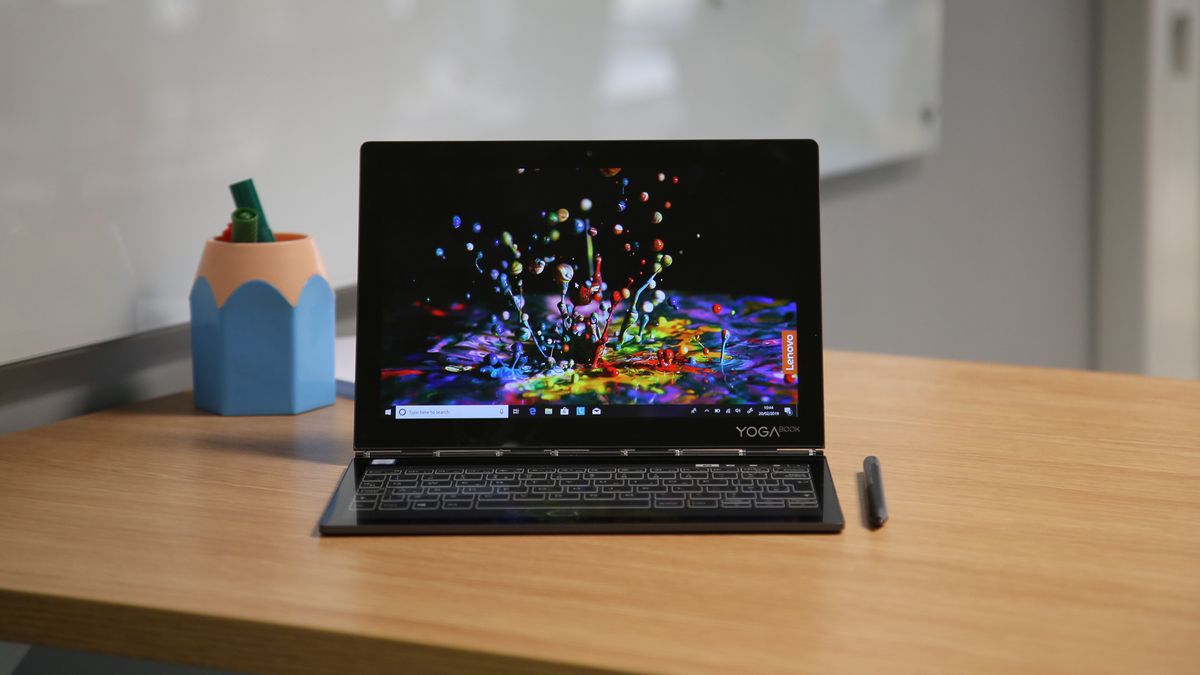TechRadar Verdict
The Lenovo Yoga Book C930 is a genuinely innovative 2-in-1 laptop that’s let down by outdated components and a very high price tag.
Pros
- +
Very thin and light
- +
Gorgeous main display
- +
E Ink screen works well
Cons
- -
Very expensive
- -
Low on RAM
- -
Aging processor
Why you can trust TechRadar
Lenovo Yoga Book’s follow up, the Lenovo Yoga Book C930, tries to keep many of the things we love about the original, which is a very good thing as the Lenovo Yoga Book remains to be one of our favorite 2-in-1 laptop/tablet hybrids.
However, unlike many hardware sequels that play it safe with only a few iterative updates to their hardware, the Lenovo Yoga Book C930 also takes some big risks. Beyond addressing the issues we had with its predecessor, this laptop brings to the table an innovative feature: a second E Ink display. And, this display not just doubles as a keyboard, but it also works as a pad for making notes and drawing as well as a traditional E Ink reader for viewing documents.
Lenovo then reinforces this potentially revolutionary design with an improved hardware – certainly much more powerful than the original’s. Could Lenovo have a real hit with the Yoga Book C930? Let’s find out.
And, should you decide that it’s the way to go, keep an eye out for Black Friday and Cyber Monday deals to save you a bit of money.
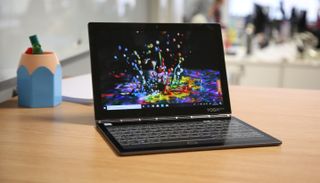
Here is the Lenovo Yoga Book C930 configuration sent to TechRadar for review:
CPU: 1.2GHz Intel Core i5-7Y54 (dual-core, 4MB cache, up to 3.2GHz boost)
Graphics: Intel HD Graphics 615
RAM: 4GB LPDDR3
Screens: 10.8-inch, QHD 2,560 x 1,600 resolution IPS touchscreen and 10.8-inch FHD 1,920 x 1,080 E Ink Mobius touchscreen
Storage: 256GB SSD
Ports: 2x USB 3.1 Type-C,
Connectivity: 802.11ac Wi-Fi (2 x 2 MIMO), Bluetooth 4.2, LTE
Camera: 720p HD webcam with infrared for Windows Hello
Weight: 1.71 pounds (0.78kg)
Size: 7.1 x 10.25 x 0.39 inches (179.4 x 260.4 x 9.9mm; W x D x H)
Price and availability
The original Yoga Book was designed by Lenovo to be an affordable 2-in-1 device that was accessible to a wide range of people thanks to its low price.
The Lenovo Yoga Book C930, on the other hand, has different aspirations, with Lenovo seemingly aiming for a more premium product. That innovative second screen also comes at a price, so the Lenovo Yoga Book C930 has ended up being a more expensive product than its predecessor.
The Lenovo Yoga Book C930 costs $929.99 (£1,299.99, AU$1,999), which is a lot more expensive than the base model for the original Yoga Book, which cost $549.99 (about £450, AU$720) for the Windows 10 version.
The almost doubling of the price means the Lenovo Yoga Book C930 is pitched at an almost entirely new market. While it’s a brave move to make such a radically different device compared to the original model, people who bought the Yoga Book and were hoping to upgrade to the latest version may feel slightly abandoned by Lenovo’s chasing of the high-end market.
In the US and Australia, there is only one model currently available, and it comes with a 7th generation Intel Core i5-7Y54 processor, Windows 10 Home, a 10-inch 2,560 x 1,600 IPS screen, 4GB of LPDDR3 memory and 256GB SSD. Graphics are handled by the integrated Intel HD Graphics 615 GPU.
In the UK, there is a base model for £1,099 that comes with a weaker Intel Core m3-7Y30 Processor and 128GB SSD, though the rest of the specs are the same. To get the model with the same Intel Core i5-7Y54 processor and SSD size as the US and Australia, the price increases to £1,299.99.
Those specs are nothing remarkable, which means the bulk of the cost of the Lenovo Yoga Book C930 appears to come from the second screen. It’s also worth noting that a battery-powered stylus is also included in the price, something the Lenovo Yoga Book C930’s competitors – such as the Surface Pro 6 – omit.
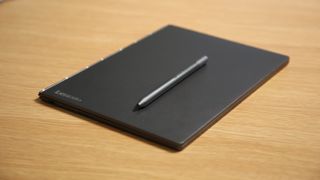
Design
Lenovo has produced some truly stunning laptops recently – especially in its Yoga range – and we’re pleased to report that the Yoga Book C930 is no different. This is a small and svelte laptop with a gorgeous watchband-link hinge, which was first introduced in the Yoga 3.
The curved hinge, as well as the Lenovo logo that runs down the left-hand side of the lid when closed, shows how indebted the design of the Yoga Book C930 is to traditional books.
When closed, it’s a remarkably thin device at just 9.9mm thick, and weighs just 775g. The thinness of the Lenovo Yoga Book C930 is mainly due to the fact that it doesn’t have a physical keyboard.
As it’s a Yoga device, the hinge allows the Yoga Book C930 to be flexible, flipping the screen so it can be used in tent mode – for watching media on, or flipped completely back to be used as a tablet. It is in tablet mode where the thin design of the Yoga Book C930 really stands out, as it allows the device to be not that much thicker – or heavier – than a standard tablet.
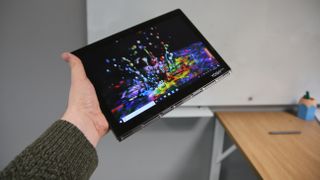
A power button and volume rocker on the device’s right side are edged in chrome, and speakers sit behind dotted grilles on either side of the ‘keyboard’.
The speakers pump out suitable range and volume despite their size, thanks to Dolby Atmos technology inside. Above the E Ink display there’s a fingerprint scanner for biometric login, and there are also two USB-C ports – one on each side – which can be used for charging.
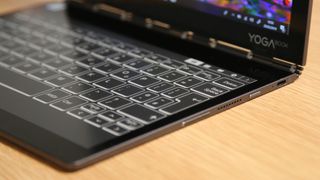
The Lenovo Yoga Book C930 also comes with a microSD slot and SIM card tray for the LTE-enabled versions. This allows you to install a smartphone SIM card into the device to access 4G mobile internet. This is a more convenient – and secure – way of getting on the internet while you’re out and about.
While the thin design is admirable and impressive, it does mean there’s no way to stow away the stylus, known as the "Precision Pen," which is a shame, and it means you’ll have to make sure you place it somewhere safe when it’s not in use. The stylus does have magnets that allows it to attach to the Yoga Book C930’s body, but we wouldn’t trust it to hold on to the stylus while you carry it about.
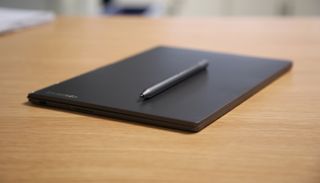
The main display has had a big update since the last version, and is now a 10.8-inch IPS panel with a QHD resolution of 2,560 x 1,600. That’s slightly larger than the previous model’s 10.1-inch screen size, and a sharper resolution (the original had a 1080p display).
It’s the high resolution that really makes the main display of the Lenovo Yoga Book C930 stand out, with the QHD resolution packed into 10.8 inches providing remarkably sharp and clear image quality thanks to its 281 ppi (pixels per inch) pixel density. With a brightness of 500 nits and an 85% color gamut, the screen of the Lenovo Yoga Book C930 really is beautiful to behold.
Less impressive are the chunky bezels that surround the screen. We’ve been spoiled recently by laptops with thin bezels that reduce the overall size of the device while giving prominence to the display. With the Lenovo Yoga Book C930, these large bezels feel rather old fashioned, and slimming them down could have made the device even smaller.
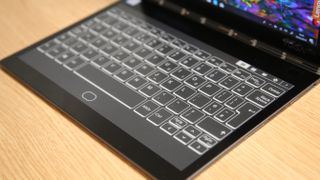
Second screen
Perhaps the biggest selling point of the Lenovo Yoga Book C930 is the second screen that not only doubles as a keyboard, but also as a drawing pad and ebook reader as well. We’ve seen dual-screen devices before, but with the Lenovo Yoga Book C930 it seems like a natural fit.
It helps that the Lenovo Yoga Book C930 uses E Ink display technology for the screen, which is found on most ebook readers, rather than Lenovo’s own proprietary Create Pad with capacitive touch and EMR pen technology.
This gives the second screen a lot more power and flexibility, so more apps can be displayed on it, and it can be used to read documents. The screen is larger, with a virtual touchpad that expands when tapped, then shrinks when not in use. In practice, it works well.
While typing on a screen will never feel as responsive or tactile as using a physical keyboard, Lenovo has included some clever tricks in the screen to make it feel more comfortable to write on. So, there’s an improved haptic feedback which lightly vibrates the screen when you push a key, along with subtle animations that make it appear like the keys are moving when pressed.
It helps make typing on the Lenovo Yoga Book C930 feel more natural to type on, though it doesn’t quite match typing on a physical keyboard. For fast typers (like we are), you may experience a slight lag to both the button press animations and the letters appearing in your document as you type, which can be a bit disconcerting.
Still, we are pleasantly surprised by how nice it feels to type on the screen. By tapping on the icons in the top-right corner of second display, you can switch between modes.
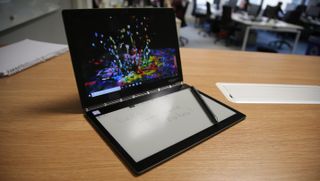
The drawing/note mode allows you to draw or write on a blank page using the new stylus, which is based on active electrostatic (AES) technology that utilizes a conductive pen tip to cause reactions in the E Ink display’s digitizer. The end result is a far quicker drawing response, with the digital cursor following your pen nearly one-to-one.
There’s also a reading mode which allows you to view compatible files – such as PDFs and ebooks – and read them on the E Ink display. It works well, and means if you’re thinking of buying a new laptop and a new ebook reader, then the Lenovo Yoga Book C930 could be the device for you, and save you some money as well.
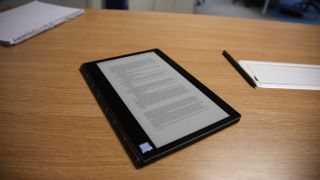
Reading documents is so much more comfortable on the E Ink display, which has a low-light matt effect that makes it feel similar to reading text on paper. It’s a shame that you can’t edit or write notes on the documents in this mode, but it’s a nice additional feature that’s a welcome addition to the Lenovo Yoga Book C930.
Image Credits: TechRadar
- You could save on Lenovo products with our Lenovo promo codes.

Matt is TechRadar's Managing Editor for Core Tech, looking after computing and mobile technology. Having written for a number of publications such as PC Plus, PC Format, T3 and Linux Format, there's no aspect of technology that Matt isn't passionate about, especially computing and PC gaming. He’s personally reviewed and used most of the laptops in our best laptops guide - and since joining TechRadar in 2014, he's reviewed over 250 laptops and computing accessories personally.
